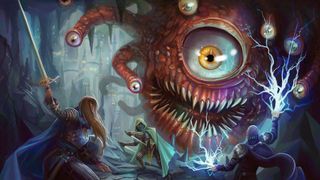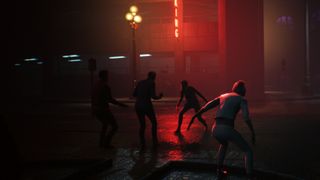How Baldur's Gate 3 and Bloodlines 2 are rewriting the rules of the tabletop games they're adapting
What works for a pen-and-paper campaign doesn't always work for a videogame.

You can tell tabletop roleplaying games are in the midst of a renaissance because suddenly everyone is making videogame adaptations of them again. Some of this year and next year's biggest projects are based on tabletop games: Dungeons & Dragons, Cyberpunk 2020, Pathfinder, Vampire: The Masquerade, and the list goes on.
But converting tabletop rules to digital form obviously isn't as simple as translating every page of the Player's Handbook into code. Combat and stats, the bits rooted in numbers, are often easy enough to reproduce, but they're only a small component of tabletop role-playing—and for many, not even the important part. I recently sat down with developers behind Baldur's Gate 3, Bloodlines 2, and Pathfinder: Kingmaker to discuss staying faithful to the source material, where it made sense for them to diverge, and—perhaps most surprising—what happens when their experiments are so successful they end up back in the tabletop version.
Bending the rules
You want to make it feel as much like the tabletop version as possible, but it's a videogame. You have to adapt.
Brian Mitsoda, Troika Games
The fifth edition of Dungeons & Dragons is around 900 pages, minus appendices: 289 for the Dungeon Master's Guide, 289 more for the Player's Handbook, and 316 for the Monster Manual. Inside these three books are rules for classes, combat, exploration—everything (minus the dice) you'd need to run your own campaign. But these books, no matter their heft, are just paper. The magic of tabletop comes from the players, from the so-called Theater of the Mind, and from one simple question: "An excellent Dungeon Master asks 'What do you do?'" says Larian founder Swen Vincke.
Perhaps the party comes across a band of kobolds. Your players could attack, sure—or they could try and barter with the kobolds, or try to mimic a kobold mating call, or name one Josh and challenge him to do squats. "The Dungeon Master decides, 'Well, we're going to do this kind of check and we're going to roll with it,'" says Vincke, meaning the person running the campaign adapts the rules to fit the situation as best they can, and then the dice decide whether the players succeed in their chicanery.
Do the rules matter? Of course, but the joy of tabletop is near-boundless freedom, the improvisational approach to collaborative storytelling.
Videogames are different, by necessity. "When making a videogame, you as the player ask 'What can I do?'" says Vincke. Regarding Larian's work on Baldur's Gate 3, he says "Our goal has been to broaden as much as possible 'What can you do?' so you start feeling like you're playing [a tabletop] campaign."
"We've done a lot more than people expect, I think," he continues. Still, cuts have to be made. "We made a list of everything that's in the Player's Handbook, and we coded it green, orange, red. Green, meaning [we can use it as-written]. Orange, needs change. Red, impossible—or maybe not impossible, but we'd have to make a completely new game just to support this feature."
The biggest gaming news, reviews and hardware deals
Keep up to date with the most important stories and the best deals, as picked by the PC Gamer team.
It's not just combat, either. It's easy to get hung up on the mechanics of spells, monster stats, and so on, but many times it's the between-the-lines bits that end up mattering most when it comes to capturing the feel of tabletop in a videogame. Alexander Mishulin, creative director at Owlcat Games, told me how much work went into Pathfinder: Kingmaker's rest system, for instance.
"Players at the table spend a lot of time camping—finding a nice place to rest, hunting, standing watch, discussing further plans," he says. "Usually CRPGs skip or reduce such activities to something like 'You pressed the Rest button.' We introduced camps where companions discuss current events, go hunting, camouflage the camp, or prepare food. When we put that into Kingmaker, we sensed some of that feeling we had at the table planning the camp."
And sometimes tabletop rules are best left on the cutting room floor. "There's always a delicate balance," says Brian Mitsoda, narrative lead on Vampire: The Masquerade – Bloodlines 2. "You want to make it feel as much like the tabletop version as possible, but it's a videogame. You have to adapt."
If you don't, you risk falling into the same trap Mitsoda and the rest of the Troika team did on the original Bloodlines back in 2004, trying to hew close to the then well-established World of Darkness 2.0 system. "There are skills that are good for tabletop but maybe not so great for a videogame," he says. "For example, we had something like Investigation in the first [game], and how often does that come up?"
If you haven't played the original Bloodlines, the answer is: Not often. The Inspection feat was basically a particle effect that emitted blue sparks from a handful of interactive objects and the occasional semi-hidden treasure. You could go the whole game without putting a single point in it and have essentially the same experience. "We want to make sure every skill we have in [Bloodlines 2] is practical, and that you feel good about putting points in it."
Occasionally the solutions are already baked into the tabletop version, as Owlcat discovered. "We wanted to use a smaller amount of skills because we lacked interactions for half the skills in Pathfinder," says Mishulin. "In Pathfinder Unchained there is a system called Consolidated Skills which we took as a base for our decisions."
Other times it requires a full-scale redesign. "The fighter has been a big problem for us" says Vincke, "because in the beginning he's very limited. He's a tutorial class in D&D 5e, but if I don't give you anything to do with your fighter in the beginning of a videogame you'll go bananas, especially when you play multiplayer."
"We started changing things that we saw didn't work—and by did not work, you should interpret that as it wasn't fun," he adds.
That doesn't mean you change everything, as sometimes it's a matter of simply educating the player. Owlcat struggled a bit with this in Pathfinder: Kingmaker. "We could have done a better job explaining [Pathfinder's] rules to new players," admits Mishulin.

One segment early on springs to mind. Longtime Pathfinder fans might know Spider Swarms are immune to single-target spells and attacks because, well, they're a swarm. Someone coming to Kingmaker without that tabletop knowledge might not understand why every attack is doing zero damage, though, and as a result there's many a forum thread filled with people asking how you kill one of the earliest enemies in the game. (Hint: It's splash damage.)
Again, Mishulin's takeaway is that Owlcat needed to better teach its players how Pathfinder works. But there's no one right way to approach the problem. A different developer might simply change the rules instead, program it so swarms react to attacks the same as any other enemy. The same divide is often seen between different tabletop groups: One Dungeon Master might stick to the letter of the law, another might let a player get away with all manner of nonsense if it's better for the story or is good for a laugh.
Flowing both directions
We started changing things that we saw didn't work—and by did not work, you should interpret that as it wasn't fun.
Swen Vincke, Larian Studios
Occasionally a videogame's rule changes are good enough to ripple back to the source material. That's the benefit of working alongside the tabletop designers—a facet Larian is particularly keen to emphasize, with Wizards of the Coast's Mike Mearls, design lead for D&D 5e, sitting in on my interview with Vincke.
"It's been fun," says Mearls. "You've got this system and you're letting another expert come and take a look at it. Of course you're going to take notes on the feedback they give you."
Mearls gives one concrete example: The Ranger. A notorious letdown in D&D 5e, much to the chagrin of all Aragorn fans (myself included), Wizards knew the Ranger needed tweaking and started experimenting with changes. "I shot those over to Nick [Pechenin, Larian's systems designer] and he was like 'We've already identified some of the same problems,'" says Mearls. "The solutions Larian was arriving at are very similar to the solutions we're rolling out, so it gives you some faith maybe you're on the right path."
"Even mechanically we talked about spells slots and stuff. Is that the best way to represent something?" he continues. "Does the fighter really have to be the tutorial class? It shouldn't matter what class you want to play when you start. Maybe every class should have a tutorial option."
Of course, books are books. They're immutable, and D&D 5e is going on five years old now. I ask Mearls what these changes mean for the tabletop version. Are we in for a D&D 5.5, like the vaunted D&D 3.5 of old?
"In an ideal world we could patch books," says Mearls, laughing. But there's no D&D 5.5 in the works. "The goal is always to make the players feel like they just need the players handbook," he continues, "But if you buy the expansion or grab the download, you can then choose this alternate option." It's additive in other words, a different take on the Ranger class for those who collect all the D&D books, a bonus for the dedicated fan—as in Mordenkainen's Tome of Foes and Volo's Guide to Monsters, both Monster Manual supplements.

Meanwhile, Paizo is replacing the tabletop version of Pathfinder: Kingmaker with a newer version. "Paizo recently had a crowdfunding campaign aimed at releasing an expanded hardcover compilation of Kingmaker [the tabletop module] in 2020," says Mishulin. "We are humbled and proud that Paizo decided to include some of our companions and changes to the story in this new version."
And with Bloodlines 2, Mitsoda and the rest of the Hardsuit Labs team found themselves in a privileged position. "We started years ago," says Mitsoda. "The tabletop team was putting out their new version as we were developing the game systems, so we've bled into the tabletop version as well." He points to the Resonance system as a specific example. In Vampire: The Masquerade 5e, consuming a person's blood comes with bonuses based on their mood. "Resonance is something we developed for our game, and it made it to the tabletop version."
There's a rich back-and-forth occurring, and hopefully the games will be stronger for it—both digital and tabletop. "It's giving us permission to pull in things that aren't very central to D&D but are fun to play with and help tell this story," says Mearls. "Things that are distinct about D&D, like spell jamming or mind flayers." Fan service, if you will.
But for someone, somewhere, these games aren't the fulfillment of years of wishing—they're the beginning. The original Baldur's Gate (all five CD-ROMs of it) was my first exposure to D&D, and sparked a lifelong fascination with tabletop gaming. Maybe Baldur's Gate 3 will do the same for someone else, or Vampire: The Masquerade – Bloodlines 2 or Pathfinder: Kingmaker.
As Vincke puts it, "We're making this game not only for people that love Dungeons and Dragons but also people who have never heard of Dungeons and Dragons, so that they can discover this entire world." And this time around, they can do so without having to look up what THAC0 stands for. Today's kids will never know how good they have it.
Most Popular

